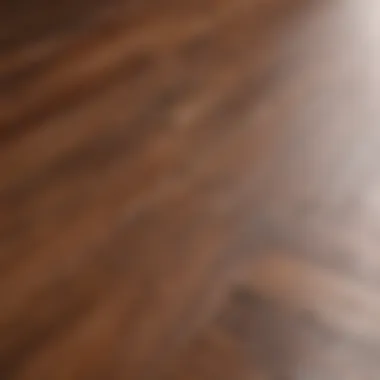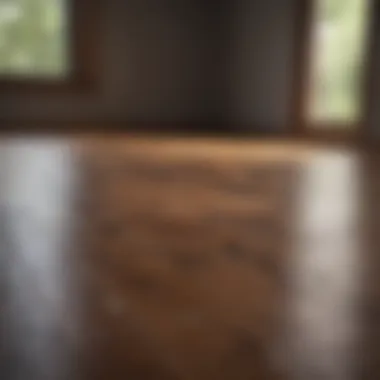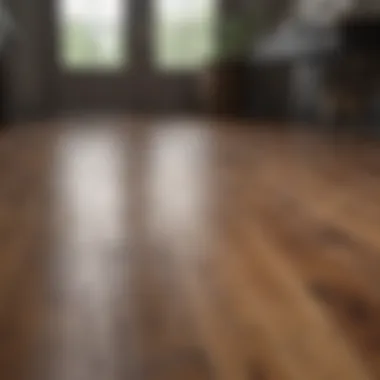Understanding the Costs of Hardwood Installation


Intro
Hardwood flooring offers both elegance and durability, making it a popular choice for many homeowners. However, understanding the overall costs associated with its installation is essential for making an informed decision. This article will dissect the financial aspects of hardwood installation, encompassing materials, labor, and the various elements that affect pricing. Furthermore, we will discuss installation methods, exploration of maintenance, and geographic price differences. By offering budgeting strategies and comparing different hardwood options, this piece aims to arm homeowners with the relevant knowledge they need.
Design Inspiration
Trending Styles
The aesthetics of a home are incredibly important. Hardwood flooring can greatly influence the overall look. Trending styles vary, encompassing everything from rustic to modern designs. For instance, wide planks are gaining popularity for their contemporary appeal, while reclaimed wood often draws attention for its unique character. Homeowners should consider their personal style when selecting a floor type. The choice should resonate with the overall theme of the house.
Color Palettes
Color choices for hardwood flooring can greatly affect the ambiance of a room. Light tones, such as oak or maple, can create a spacious and airy feeling. Darker shades, like espresso or walnut, often add a touch of sophistication. To make the best choice, consider existing décor and natural light in your space. Samples can provide crucial insights into how different colors will look when applied in your home.
Practical Tips
Maintenance & Care
Proper maintenance of hardwood floors is vital to extend their lifespan. Regular cleaning with a damp mop and using appropriate cleaning solutions will help maintain the finish. Avoid excessive water exposure, as it may warp the wood. Additionally, placing rugs at entry points can minimize dirt and grime, preserving the floor's surface.
Budgeting & Planning
Budgeting for hardwood installation involves several factors. First, calculate the cost of materials. Prices can vary significantly depending on the wood species and finish. Then, consider labor costs, which can fluctuate based on installation complexity and local market rates. Always include a contingency for unexpected expenses. Additionally, doing a thorough comparison of hardwood options will help ensure that both aesthetic desires and financial constraints align.
"Investing in quality hardwood is not just about the immediate costs, but also the long-term value it provides through durability and style."
Careful planning can lead to a successful installation, making best use of your resources and enhancing your living space.
Prelims to Hardwood Flooring
Hardwood flooring offers not only aesthetic appeal but also longevity, making it a compelling choice for many homeowners. Understanding this type of flooring is essential before embarking on an installation. This section aims to explain hardwood flooring, its materials, and why it remains a popular option in various homes.
What is Hardwood Flooring?
Hardwood flooring is a type of flooring made from solid wood or engineered wood. Solid hardwood is precisely what it sounds like—a single piece of wood that provides a sturdy and durable surface. In contrast, engineered hardwood consists of several layers, with real wood on top and plywood beneath.
The variety of trees used can range from oak, maple, and cherry to exotic options like teak or mahogany. Each type not only offers unique colors and grains but also varying levels of hardness. This feature is important when considering the floor's longevity and resistance to wear.
Why Choose Hardwood?
Hardwood flooring provides several benefits that appeal to a range of homeowners. First, it is known for its durability. With proper maintenance, hardwood can last for decades, often outlasting other flooring types. Additionally, hardwood adds a certain elegance to any space, making it attractive to those focused on home aesthetics.
Another key advantage is the ease of cleaning. Unlike carpets that trap allergens and dirt, hardwood’s smooth surface allows for straightforward maintenance. Regular sweeping or vacuuming, along with occasional mopping, keeps it in good condition.
Moreover, hardwood is also a sustainable option. When sourced responsibly, it can be a more eco-friendly choice compared to synthetic floorings.
Factors Influencing Hardwood Installation Costs
Understanding the factors that influence hardwood installation costs is essential for homeowners looking to undertake a flooring project. Many elements come into play when estimating costs, from the type of hardwood chosen to the specific installation method employed. Each choice has financial implications that can significantly affect the overall budget, making it crucial to evaluate these factors carefully.
Type of Hardwood
The type of hardwood selected plays a fundamental role in determining the overall cost of installation. Different species, such as oak or maple, offer varied prices and qualities that influence the budget.
Solid Hardwood


Solid hardwood is a classic choice and often considered the most durable. Its key characteristic is that it is made from a single piece of wood. This design contributes to its longevity and ability to be refinished multiple times, which adds value over the years. However, solid hardwood can be sensitive to humidity and temperature changes, potentially leading to expansion or contraction.
The advantages of solid hardwood include its aesthetic appeal and robust feel underfoot, but the disadvantage is its higher cost compared to other options.
Engineered Hardwood
Engineered hardwood consists of a veneer layer of solid wood on top of several layers of plywood. This construction helps it withstand changes in humidity better than solid hardwood. The primary benefit of engineered hardwood is its stability, making it suitable for basements or areas experiencing moisture. Moreover, it tends to be less expensive than solid hardwood while still providing an attractive wood appearance.
However, the unique feature of engineered hardwood is that it can only be refinished once or twice, which limits its lifespan compared to solid options.
Bamboo
Bamboo is an eco-friendly alternative to traditional hardwoods. It is technically a grass, which allows it to grow faster than trees. This characteristic makes it a sustainable choice and often more affordable than solid hardwood. Bamboo is notable for its hardness and durability, making it resistant to scratches.
On the downside, its susceptibility to moisture is a concern. While bamboo offers environmental benefits, it may not be the ideal choice for all homes.
Installation Method
The method used for installation can dramatically impact labor costs and the overall expense. Each installation type comes with its own requirements and expertise levels needed.
Nail Down
The nail down method involves fastening hardwood planks to a wooden subfloor using nails. This method is often regarded as traditional and is commonly used for solid hardwood. Its main advantage is that it allows for natural expansion and contraction of the wood, reducing the likelihood of warping.
However, the need for a sturdy subfloor can make this method less viable in certain situations, resulting in higher costs if additional work is required.
Glue Down
Glue down installation involves using adhesive to attach the flooring directly to the subfloor. This method can be used with both solid and engineered hardwood. Its key feature is that it can be applied over various surfaces, including concrete. This flexibility often makes it a popular choice in diverse environments.
However, it requires precise application and can be labor-intensive, which can raise costs if not performed by an experienced professional.
Floating
Floating installation does not bond the flooring to the subfloor. Instead, planks interlock and rest on an underlayment. This method is typically used for engineered hardwood and bamboo. Its significant advantage is that it is the easiest method for DIY projects, reducing labor costs.
Yet, it may also produce more noise when walked upon and does not offer the same solid feel as nailed or glued installations.
Geographic Location
Geographic location impacts costs significantly due to varying labor rates, material availability, and regional demand. Urban areas typically have higher installation costs due to higher living expenses. Further, some wood species may be more accessible in certain regions, affecting pricing based on supply and demand.
Room Size and Layout
The size and layout of the room are critical elements in determining installation costs. Larger spaces will require more material, naturally leading to higher expenditures. Additionally, intricate layouts with multiple angles and features may necessitate additional labor, further increasing the overall cost.
Subfloor Condition
The condition of the subfloor is paramount when assessing installation costs. If the subfloor is damaged or uneven, it may require preparation like leveling, which can incur extra expenses. A well-prepared subfloor often results in a smoother installation process and improved performance of the hardwood flooring.
Breakdown of Hardwood Flooring Costs
Understanding the breakdown of hardwood flooring costs is essential for homeowners making informed decisions about their flooring choice. Each component, from material selection to labor charges, plays a critical role in determining the overall price. By examining these individual elements, homeowners can budget better and anticipate potential expenses. Knowledge of the cost breakdown allows one to prioritize needs and make strategic choices that align with both financial constraints and aesthetic desires.
Material Costs
Average Prices
The average prices of hardwood flooring vary based on several factors, including type, quality, and market variables. Generally, solid hardwood ranges between $5 and $15 per square foot, while engineered hardwood typically sits between $3 and $12 per square foot. Understanding these averages can assist homeowners in estimating budget requirements effectively. A significant portion of the expenditure can stem from choosing premium hardwood species, which can enhance both beauty and durability. However, it is crucial to weigh costs against the benefits that high-quality materials offer in terms of lifespan and maintenance.
Brand Variations
Brand variations can greatly influence hardwood flooring prices as different manufacturers offer products with varying quality levels, finishes, and warranties. Popular brands often carry a premium due to established reputations for reliability and innovation. It's wise to analyze brands to ensure that a chosen product not only fits the budget but also meets desired performance criteria. Some well-known brands provide extensive guarantees, which can be beneficial in the long run. However, selecting lesser-known brands may reduce initial costs but could come with risks regarding quality and support.
Sourcing
Sourcing of hardwood influences the final cost significantly. Local sourcing often means lower transportation costs, which can lead to lower overall prices. Global sourcing can increase costs due to shipping and tariffs, especially for exotic species. While sourcing locally supports community businesses, imported options may offer unique styles. It’s important for buyers to evaluate the overall quality and the environmental impact associated with sourcing methods. Strong sourcing practices tend to provide higher quality options and a more sustainable choice.
Labor Costs


Regional Variations
Labor costs vary geographically, reflecting local economies and demand for skilled workers. Urban areas tend to have higher rates due to increased demand and cost of living. In contrast, more rural areas may offer lower rates but might have less choice in skilled labor. Being aware of these regional variations helps homeowners plan their budgets realistically. Choosing local labor may also lead to better communication and accountability.
Experience Level
The experience level of the installer affects labor costs significantly. Highly skilled professionals generally charge more, reflecting their expertise and the quality of work they deliver. Although opting for less experienced workers may seem cost-effective, it can lead to complications and higher long-term costs if the installation is not performed correctly. Therefore, investing in more experienced labor can ultimately save homeowners from potential issues.
Installation Complexity
The installation complexity can also heavily influence labor costs. Straightforward installations demand less time and expertise, leading to lower costs. In contrast, intricate layouts��—like herringbone or custom patterns—require more skill and time, thus increasing labor charges. Understanding this aspect allows homeowners to make informed decisions on design preferences without unforeseen expenses.
Additional Expenses
Underlayment
Cost of underlayment varies depending on the material and quality. It serves as a cushion between the hardwood and the subfloor, providing moisture protection and noise reduction. High-quality underlayment adds to the overall comfort of the floor. While it is an additional expense, it considerably enhances the longevity and performance of the flooring.
Trims and Moldings
Trims and moldings complete the aesthetic of hardwood flooring and contribute to the overall look of a room. The good quality trims can vary widely in price, depending on the material and style chosen. Investing in matching or higher-quality trims ensures cohesive aesthetics, while lower-cost options may not integrate well visually, impacting the overall effect.
Removal of Old Flooring
If previous flooring needs removal, this is an additional cost. This process can be labor-intensive, especially if the old flooring system is glued down or nailed. Budgeting for this expense is essential as it can range widely based on the flooring type and labor rates. Homeowners should factor this into their overall plans to avoid unexpected costs during the installation process.
Comparing Hardwood Flooring Options
In the context of understanding the costs associated with hardwood installation, it is essential to compare hardwood with other flooring options. This comparison not only highlights the differences in aesthetics and durability but also focuses on the long-term financial implications. Homeowners need to evaluate various flooring materials before making a decision that aligns with both their design preferences and budget constraints. The decision on flooring can significantly affect future maintenance costs, resale value, and overall satisfaction.
Hardwood vs. Other Flooring Options
Laminate
Laminate flooring is often seen as a cost-effective alternative to hardwood. Its primary characteristic is the ability to mimic the appearance of wood while being more affordable. Laminate is an attractive choice for those on a tight budget or seeking an easy installation process. The unique feature here is that laminate comes with a protective coating, making it resilient against scratches and stains. However, its lack of genuine wood can deter some buyers.
Advantages of laminate include its lower price point and simplicity in maintenance, making it a popular choice for busy households. A drawback is its inability to be refinished, which limits its lifespan compared to hardwood.
Vinyl
Vinyl flooring stands out due to its versatility and water-resistant nature. This characteristic makes it especially suitable for areas prone to moisture, such as kitchens and bathrooms. The unique feature of vinyl is its vast array of designs and styles, including options that resemble high-end wood looks at a fraction of the cost.
While vinyl is easy to maintain and install, it may not offer the same warmth and appeal as hardwood, acting as a trade-off for homeowners who value aesthetics. Furthermore, vinyl can be less durable over the long term, which means it may require more frequent replacements.
Tile
Tile flooring is another option, often chosen for its durability and resistance to moisture. The key characteristic of tile is its ability to withstand heavy foot traffic and its low-maintenance requirements. This can be particularly beneficial in bathrooms or entryways where spills are common. A unique feature of tile is its wide variety of textures and colors, giving homeowners an extensive selection to consider.
However, tile can feel colder underfoot and may lack the warmth that hardwood provides. Installation can be quite labor-intensive and more costly in terms of labor and material costs. Thus, understanding these aspects is crucial for a homeowner weighing their flooring options.
Long-Term Costs of Hardwood
The long-term costs associated with hardwood flooring go beyond installation. Homeowners should consider maintenance and resale value as critical aspects of their investment.
Maintenance


In terms of maintenance, hardwood flooring requires regular upkeep to maintain its appearance and longevity. This aspect includes refinishing and sealing to protect the wood. The key characteristic is that while hardwood can be costly upfront, its durability makes it a sound choice in the long run, provided it is cared for correctly.
The unique feature of hardwood maintenance is its ability to restore the floor's finish, extending the life of the installation, which is beneficial for those looking to stay in their homes long-term.
However, neglecting proper maintenance can lead to damage that may be expensive to repair, emphasizing the need for a commitment to care.
Resale Value
Lastly, the resale value of hardwood flooring is typically higher than that of other flooring types. Many buyers seek homes with hardwood, seeing it as a sign of quality and attention to detail. The key characteristic here is that hardwood can enhance the overall value of a property over time.
The unique feature of hardwood’s resale value is that it tends to remain stable even in fluctuating market conditions. Though the initial investment is substantial, it can yield significant returns if the home is sold. Therefore, homeowners must evaluate the potential long-term benefits against the immediate costs of installation and maintenance.
Considering these comparisons helps homeowners make informed decisions that align with their financial and lifestyle goals.
Budgeting for Hardwood Installation
When considering hardwood installation, proper budgeting is crucial. This financial plan establishes a framework for what you can afford and helps in preparing for unforeseen expenses. A well-structured budget minimizes surprises and guides the homeowner toward desired outcomes. It allows for informed decisions about materials, labor, and additional costs. Effective budgeting also sets clear boundaries, preventing overspending. Therefore, it’s essential to grasp the key components that impact total expenses.
Creating a Budget Plan
Creating a budget plan is an effective strategy for managing costs. This involves identifying various expenses related to hardwood installation, from materials to labor. An organized budget plan lays the groundwork for financial preparedness.
Setting Priorities
Setting priorities is the process of determining which aspects of the installation are most important. It can focus on style, type of wood, or installation method. The main characteristic is that it allows for clarity in decision-making. This is beneficial because it ensures that funds are directed toward areas that add the most value or interest. A unique feature is that it reflects personal preferences. However, prioritizing some aspects may mean sacrificing others, which can limit options in some cases.
Allocating Funds
Allocating funds involves distributing your total budget across various categories. This is crucial because it helps in managing different elements of the flooring project. The key characteristic here is its structured approach to financial management. It prevents overspending in one area by ensuring that each component of the project receives an appropriate share. A unique feature is its flexibility; homeowners can adjust allocations based on current priorities or available funds. A disadvantage is that if funds are not allocated precisely, it could lead to unexpected shortfalls or budget overruns.
Financing Options
Financing options can be essential for those who cannot fully fund their installation upfront. This section explores several avenues available to homeowners.
Loans
Loans can be a solution for financing hardwood installation. They provide homeowners with immediate access to necessary funds. A key characteristic of loans is their structured repayment plans. They offer predictability in budgeting since monthly payments are fixed. Loans facilitate larger projects without requiring full upfront costs. However, a potential downside is interest accruement, which can increase total costs over time.
Leases
Leasing is another option for financing hardwood installations. This method allows homeowners to use flooring materials for a defined period, making it valuable for those uncertain about permanent commitment. The primary characteristic of leases is that they often require lower upfront costs than direct purchases. This method is popular as it provides flexibility in design choices without commitment. Unique to leasing is the option to purchase at the end of the term. A downside could be that continual payments may lead to higher long-term costs if a homeowner decides to keep the flooring.
Credit Options
Credit options, like credit cards or home equity lines of credit, are flexible financing choices. They allow for immediate purchase while giving space to pay off the cost over time. A key characteristic is accessibility; most homeowners already have credit options available. This choice is particularly beneficial for emergencies or smaller projects needing quick funding. The unique feature lies in its ease of use, especially for short-term needs. However, high-interest rates and the possibility of overspending are notable downsides.
Each of these financing options comes with its own set of advantages and disadvantages. Understanding them can help homeowners make a more informed decision about their flooring projects.
Culmination
Understanding the costs associated with hardwood installation is crucial for homeowners and design enthusiasts alike. It not only involves evaluating the price of materials but also labor, installation methods, and additional expenses. Having a comprehensive grasp of these elements enables better decision making, ensuring that the chosen flooring aligns with both aesthetic desires and budget constraints.
One must consider several factors when planning for hardwood flooring. For instance, the choice between solid hardwood and engineered products can significantly affect costs, yet also influence longevity and maintenance. The installation method selected can vary in complexity and subsequent labor costs, even within the same type of material. The geographic location impacts pricing too, due to differences in labor rates and availability of materials.
Additionally, budgeting for hardwood flooring requires more than just purchasing the materials. Expenses such as underlayment, trims, and possible removal of old flooring add layers to the overall investment. Evaluating different financing options can also provide flexibility and make the project more manageable.
Comparing hardwood to other flooring choices, like laminate or vinyl, highlights the potential long-term value of hardwood. Its durability and timeless appeal often result in a higher resale value, making it an investment worth considering. Proper maintenance guidelines can prolong the life of hardwood, enhancing its overall value over time.
Ultimately, the goal is to integrate personal preference with financial intelligence. As you navigate these considerations, remember to continuously assess your priorities and needs, ensuring that your choice reflects your lifestyle and enhances your home environment. This article aims to empower you with insights, enabling informed decisions regarding your hardwood flooring journey.
"Investing in hardwood flooring is not just about aesthetics. It serves as a long-term commitment to your living space."
By approaching your hardwood installation with a strategic mindset, you will find that the benefits often outweigh initial costs. Thorough research and planning can transform hardwood flooring from mere wood slabs to a distinguished feature of your home.















